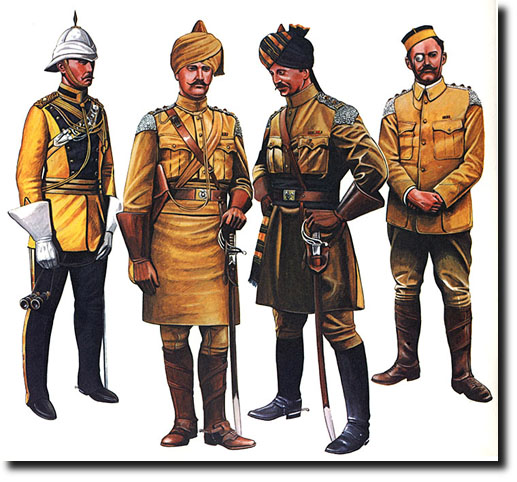|
|

 |
| The left-hand officer (c1901) is in European full dress, worn when not parading with the men. He is in dismounted order which means overalls and Wellington boots (ie trousers with calf-length boots underneath) and the caplines finishing up round the neck instead of being attached to the back of the helmet. The helmet is the foreign service cork type covered in white cloth and having a white pugri. It is fitted with a gilt spike and chin-chain. The distinctive yellow tunic with black facings (see British Officer's Tunic) has a gold and black girdle round the waist which is purely decorative as the sword is suspended from a web belt worn under the tunic. The caplines are confusing but basically wind round the body on the right shoulder while the pouchbelt is worn over them on the left shoulder. It is the same pouchbelt as that worn in Indian full dress (see Pouchbelt 1901-03). The overalls are black with two gold stripes as were the breeches which were worn when mounted. In 1913 the dress regulations state that the stripes were yellow cloth. The officer next to him is a lieutenant in marching order c1907. His lungi is khaki but is based on the gold and red kullah. He has a khaki kurta and kummerbund and brown leather Sam Browne belt holding a revolver holster and sword. The belt is fastened with a regimental belt plate. Next is an officer in drill order c1907. He wears the Officer's Full Dress Lungi and a similar kummerbund to that worn in full dress but the rest is similar to marching order. The right-hand officer with a monocle is in European undress with a black and gold pillbox cap. At this stage (c1907) the field service cap would usually be worn in this order of dress. The gaiters are called Stohwassers. |
Armed Forces | Art and Culture | Articles | Biographies | Colonies | Discussion | Glossary | Home | Library | Links | Map Room | Sources and Media | Science and Technology | Search | Student Zone | Timelines | TV & Film | Wargames
